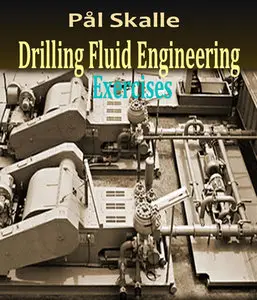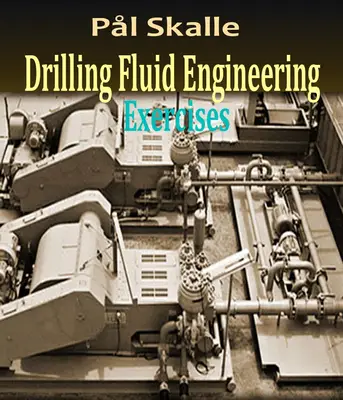"Drilling Fluid Engineering: Exercises" by Pål Skalle
BoBoCoAe, PS & Ventus Publishing ApS | 2011 | ISBN: 8776818659 9788776818654 | 101 pages | PDF | 6 MB
BoBoCoAe, PS & Ventus Publishing ApS | 2011 | ISBN: 8776818659 9788776818654 | 101 pages | PDF | 6 MB
This is the exercise book accompanying Drilling Fluid Engineering. This book presents how to apply fluid mechanics on drilling fluid related challenges and explains the related physics involved and the different engineering approaches.
Mud has many functions, the single most important one is to remove the cuttings a) away from under the bit and b) transport them from the bottom to the surface. Viscosity of drilling fluids is not a constant parameter; it varies with shear rate. Pipe, rock bit and annular friction pressure loss has high importance for several tasks. Stable wellbore includes many sub tasks like chemical stability and filtration control.
The content has the understanding of the physics and mathematics of the processes in focus. Practical applications have also priority, but come after the physics.
Most of the exercises have been solved by students in the corresponding course at the Department of Petroleum Engineering and Applied Geophysics at NTNU of Trondheim.
Content
Preface
1 Fluid Properties
1.1 Filter loss control
1.2 Filter loss control
1.3 Filter loss control
1.4 Filter loss control
1.5 Density control
1.6 Density control
1.7 Density control
1.8 Density control
1.9 Rheology control
1.10 Rheology control
1.11 Rheology - control
1.12 Flocculation
1.13 Mud contamination
1.14 Flocculation
1.15 Fluid additives
1.16 Fluid Additives. Drag reducer
1.17 Fluid additives
1.18 Fluid additive
2 Rheological models
2.1 Bingham
2.2 Bingham/ Power law
2.3 Bingham/Power law
2.4 Bingham / Power law. Regression
2.5 Effective viscosity
2.6 All models
2.7 All models. Regression
2.8 All models
3 Drilling fluid dynamics
3.1 Velocity profile. Continuity equation
3.2 Velocity profile. Momentum flux
3.3 Velocity profile
3.4 Pressure loss vs. rheology
3.5 Pressure loss vs. rheology
3.6 Pressure loss. Power law
3.7 Pressure loss. Turbulent. Energy equation
3.8 Pressure loss vs. flow rate
3.9 Pressure loss. Field data
3.10 Pressure loss. Nozzles.OFU
3.11 Swab pressure. Cling factor
4 Hydraulic program
4.1 Mud pump issues
4.2 Parasitic pressure
4.3 Optimal nozzles? Section wise
4.4 Liner selection. Section wise
4.5 Optimal parameters for BHHP. OFU. Section wise
4.6 Hydraulic program. Section wise
4.7 Liner selection. Complete well
4.8 Liner selection. Complete well
5 Well challenges
5.1 ECD. Cuttings concentration
5.2 ECD. Solids control
5.3 ECD. Barite
5.4 ECD. Flow rate and fluid consistency
5.5 ECD. Temperature change
5.6 Water activity
5.7 Water activity
5.8 Shale stability
5.9 Clay behavior
5.10 Wellbore problem
6 Additional information
6.1 Pump and hydraulic program data
6.2 Fluid mechanic
6.3 Conversion factors
Solutions to Exercises in Drilling Fluid Engineering
1 Fluid Properties
1.1 Fluid loss control
1.2 Filter loss control
1.3 Filter loss control
1.4 Filter loss control
1.5 Density control
1.6 Density control
1.7 Density control
1.8 Density control
1.9 Rheology control
1.10 Rheology control
1.11 Rheology control
1.12 Flocculation
1.13 Mud contamination
1.14 Flocculation
1.15 Fluid additives
1.16 Drag reducer
1.17 Fluid additives
1.18 Fluid additives
2 Rheological models
2.1 Bingham
2.2 Bingham / Power law
2.3 Bingham / Power law
2.4 Bingham / Power law. Regression
2.5 Effective viscosity
2.6 All models
2.7 All models. Regression
2.8 All models
3 Drilling fluid dynamics
3.1 Velocity profile. Continuity equation
3.2 Velocity profile. Momentum flux
3.3 Flow profile
3.4 Pressure loss vs. rheology
3.5 Pressure loss vs. Rheology
3.6 Pressure loss. Power law
3.7 Pressure loss. Turbulent flow. Energy equation
3.8 Pressure loss vs. flow rate
3.9 Pressure loss. Field data
3.10 Pressure loss. Bit nozzle. OFU
3.13 Swab pressure. Clinging factor
4 Hydraulic program
4.1 Mud pump issues
4.2 Parasitic pressure
4.3 Nozzle selection. Section wise
4.4 Liner selection. Section wise
4.5 Optimal parameters with BHHP. OFU. Section wise
4.6 Hydraulic program. Section wise
4.7 Liner selection. Complete well
4.8 Liner selection. Complete well
5 Wellbore challenges
5.1 ECD. Cuttings concentration
5.2 Solids control
5.3 ECD. Barite
5.4 ECD. Flow rate + fluid consistency
5.5 ECD. Temperature influence
5.6 Water activity
5.7 Water Activity
5.8 Shale stability
5.9 Clay behavior
5.10 Wellbore problems
with TOC BookMarkLinks



